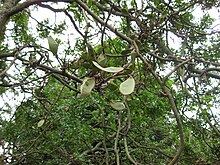Schotia
| Schotia | ||||||||||||
|---|---|---|---|---|---|---|---|---|---|---|---|---|

Schotia afra , habitus and flowers. |
||||||||||||
| Systematics | ||||||||||||
|
||||||||||||
| Scientific name | ||||||||||||
| Schotia | ||||||||||||
| Jacq. |
Schotia is a genus of plants from the tribe detarieae in the subfamily of caesalpinioideae (Caesalpinioideae) within the family of the Leguminosae (Fabaceae). They are onlynative to southern Africa .
description

Appearance and leaves


The Schotia species are unreinforced, evergreen to ( Schotia brachypetala in cooler locations) deciduous shrubs and trees .
The alternate leaves arranged on the branches are divided into a petiole and a leaf blade. There are no glands on the petioles. The pinnate leaf blades have four to eight pairs on the rachis against constant opposing pinna leaflet . The leaflets are often dark green and leathery. The small stipules are obsolete.
Inflorescences and flowers
In spring , the flowers appear in the lateral or terminal, relatively short, paniculate or racemose inflorescences, often densely packed and sometimes before the leaves appear. The bracts and bracts are small and obsolete; they do not envelop the flower buds.
The hermaphroditic, showy flowers are red. The conspicuous flower cup (hypanthium) is cup-shaped. The four unequal or equal sepals are free or they overlap like a roof tile. Only in Schotia brachypetala are all five petals roughly the same, in the other species some or all are reduced to smaller and elongated structures. Of the ten stamens , usually a short one with a long one. The stamens are fused at most at their base. The single carpel contains some ovules . The long, thin pen ending in a capitate stigma. The abundant nectar-producing flowers are visited by birds.
Fruits and seeds
With a length of mostly 10 to 15 cm, the long or elliptical, flat, pointed to tailed legumes are greenish and slightly tomentose at first, later light to dark brown and hard when ripe; they contain some seeds. The very hard seeds have a yellowish, fleshy aril .
Systematics and distribution
The only four Schotia species are of course only found south of the Zambezi , i.e. in southern Africa .
The genus Schotia was first published in 1786 by Nikolaus Joseph von Jacquin in Collectanea , 1, p. 93. Nikolaus Joseph von Jacquin, who was director of the imperial gardens of Schönbrunn , honored his head gardener Richard van der Schot , who visits South Africa, with the generic name Schotia would have. The genus Schotia belongs to the tribe detarieae in the subfamily of caesalpinioideae (Caesalpinioideae) within the family of the Leguminosae (Fabaceae). The three species formerly belonging to the genus Schotia from tropical Africa (Guineo-Congolese) were converted into the genus Leonardoxa Aubrév in 1968 by André Aubréville in Adansonia , 8, pp. 177-179 . and in 1993 by Jean Joseph Gustave Léonard in Bull. Jard. Bot. Belg. , 62, pp. 433-451 placed in the genus Normandiodendron J.Léonard . The systematics of the genus is difficult because the distribution areas of the species overlap and they form hybrids, and the species are morphologically relatively variable.
The genus Schotia only contains four or five species:
-
Schotia afra (L.) Thunb. : There are two valid varieties of this species:
- Schotia afra (L.) Thunb. var. afra : It thrives near the coast in the southern and eastern Western Cape .
- Schotia afra var. Angustifolia (E. Mey.) Harv. : It thrives in the interior of Namaqualand and Namibia .
- Schotia brachypetala Sond. : "Weeping Boer-Bean" is used as an ornamental plant in subtropical areas. It is usually a small tree. The deep red flowers produce plenty of nectar , some of which drip out (hence "weeping")
- Schotia capitata Bolle : It thrives along the coast from KwaZulu-Natal to Swaziland and Mozambique .
- Schotia latifolia Jacq. : It thrives from Riversdale in the Western Cape to near Umtata in the Eastern Cape and in Mpumalanga and Limpopo .
use
Due to their decorative flowers and their lack of demand in terms of water supply and soil quality, some species are often planted as street trees and in gardens - also outside their natural range .
swell
- Schotia brachypetala , Giles Mbambezeli & Alice Notten 2001 Schotia latifolia , Alice Aubrey 2007 at plantzafrica . (Section description, distribution and systematics)
- Entry in the Flora of Zimbabwe .
- RK Brummitt, AC Chikuni, JM Lock & RM Polhill: Flora Zambesiaca , Volume 3, 2007: Leguminosae : Online.
Individual evidence
- ↑ Schotia at Tropicos.org. Missouri Botanical Garden, St. Louis
- ↑ a b Schotia in the Germplasm Resources Information Network (GRIN), USDA , ARS , National Genetic Resources Program. National Germplasm Resources Laboratory, Beltsville, Maryland.
Web links
- Schotia . In: S. Dressler, M. Schmidt, G. Zizka (Eds.): African plants - A Photo Guide. Senckenberg, Frankfurt / Main 2014.